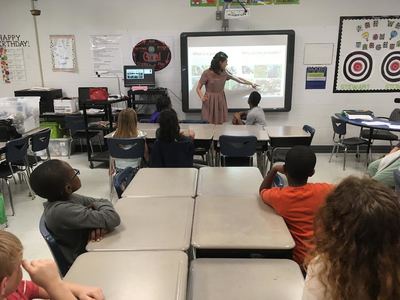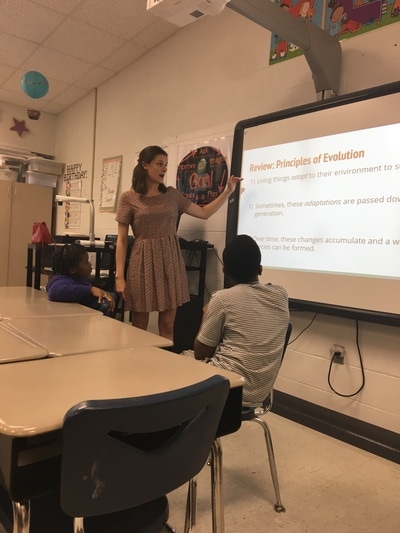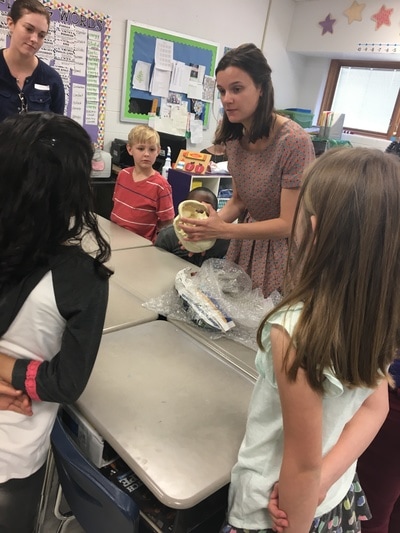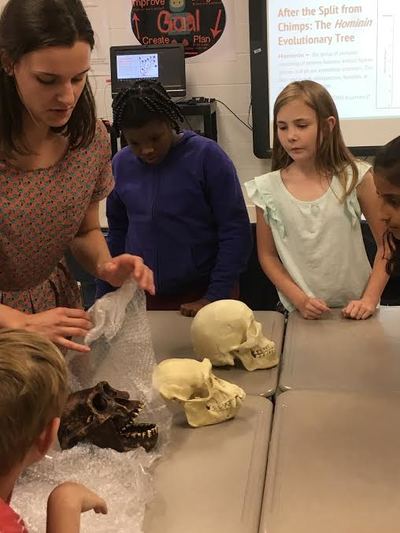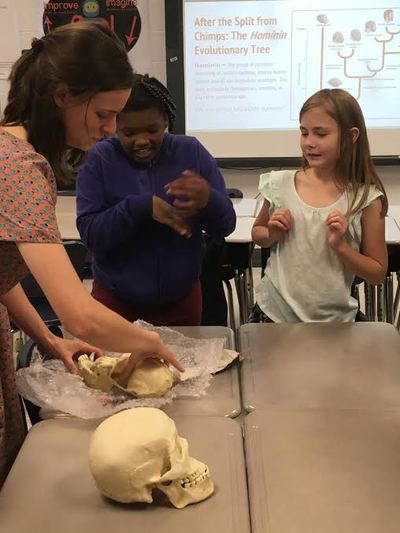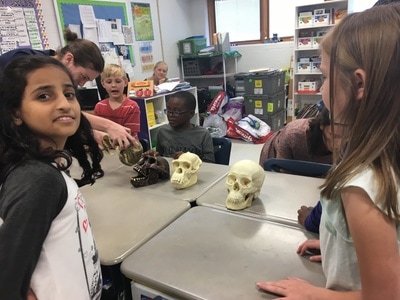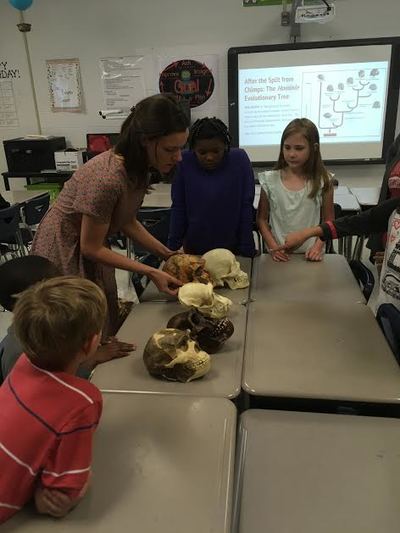Table of Contents
|
Comparative Osteology: What's this lesson all about?
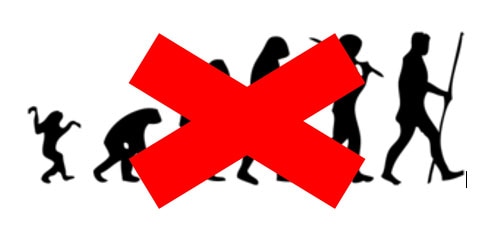 The March of Progress is an inaccurate portrayal of evolution.
The March of Progress is an inaccurate portrayal of evolution.
This week we decided to teach about human history. One of our main goals for physical anthropology is to correct the common misconception that humans evolved from present day apes; this idea is so prevalent that it has resulted in the image of the March of Progress that is widely accepted by people today.
We brought casts of skulls from humans, human ancestors, and our modern day relatives. We wanted our students to understand the relationship between humans and other primate species, and how we're different. It also exposed the students to another area of physical anthropology, osteology.
We brought casts of skulls from humans, human ancestors, and our modern day relatives. We wanted our students to understand the relationship between humans and other primate species, and how we're different. It also exposed the students to another area of physical anthropology, osteology.
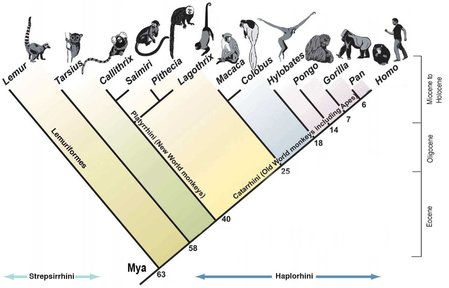 This phylogenetic tree shows the lineage of living primates. We split from chimps six million years ago.
This phylogenetic tree shows the lineage of living primates. We split from chimps six million years ago.
So, Humans Didn't Evolve From Chimps?
We often hear "humans evolved from chimps" when people explain human evolution. This is untrue. The modern day chimpanzee is just that: modern. We could not have possibly evolved from a modern species, which diverged from the species that went on to be humans about 6 million years ago.
Evolution is a slow process. When humans diverged from chimps all that time ago, our ancestor would have been smaller, furrier, and probably didn't walk up right. But after millions and millions of years, generation after generation, our ancestors slowly became more human-like.
When we illustrate the relationship between humans are our closest living relatives, we use a phylogenetic tree. This tree shows when we split from the species whose line went on to become modern day species.
We often hear "humans evolved from chimps" when people explain human evolution. This is untrue. The modern day chimpanzee is just that: modern. We could not have possibly evolved from a modern species, which diverged from the species that went on to be humans about 6 million years ago.
Evolution is a slow process. When humans diverged from chimps all that time ago, our ancestor would have been smaller, furrier, and probably didn't walk up right. But after millions and millions of years, generation after generation, our ancestors slowly became more human-like.
When we illustrate the relationship between humans are our closest living relatives, we use a phylogenetic tree. This tree shows when we split from the species whose line went on to become modern day species.
Comparative Osteology: Our Place in the Primate Family Tree Lesson Plan
By Hannah Tytus
Third, Fourth, and Fifth Grade
Seven Sessions
Lesson-Comparative Osteology: Our Place in the Primate Family Tree
Materials
Focus
Learning objectives
Guided Practice (Activity):
Third, Fourth, and Fifth Grade
Seven Sessions
Lesson-Comparative Osteology: Our Place in the Primate Family Tree
Materials
- Cooked crickets (optional)
- Skull casts (we used skulls of a chimpanzee, Australopithecus afarensis, Homo erectus, Homo Neanderthalensis, and a modern human)
- NOTE: We understand that skull casts are expensive and difficult to acquire. If no casts are available, showing pictures of chimpanzee and human anatomy (i.e. hands, feet, upright skeletons, skulls, etc.) side-by-side can help students understand how we conclude that we are most closely related to chimpanzees.
- Living things adapt to their environment to survive
- Sometimes these adaptations are passed down to the next generation
- Over time, these changes accumulate and a whole new species can be formed.
Focus
- How are we related to primates, including extinct primate species? How do we use bones to confirm this relationship?
Learning objectives
- To define and understand what classifies a primate.
- A primate is an omnivorous mammal characterized by having hands, hand-like feet, forward-facing eyes, varied locomotion, and complex behaviors.
- Primates are typically tree-dwellers.
- To know that humans are apes (not monkeys), and therefore also primates.
- Humans are considered primates because we fit all the characteristics defined above.
- To understand the function of a phylogenetic/evolutionary tree
- An evolutionary tree-or phylogenetic tree-is a diagram that shows the evolutionary relationships between different species.
- We shared a common ancestor with monkeys, but we are not descended from them.
- To visualize the physical transition from the chimpanzees to homo sapiens by observing hominin evolution
- Hominin: the group of primates consisting of modern humans, extinct human species, and all of our immediate ancestors.
- Chimpanzees, bonobos, and any other nonhuman ape is not included in this.
Guided Practice (Activity):
- Observe different parts of human and nonhuman primate anatomy.
- Ask students to identify the differences and similarities.
- Ask: how could this change have been an adaptation to the environment?
- Example: Observing the hands and feet of apes, we can hypothesize that their long fingers helped them climb trees more easily.
- Students get to eat the cooked crickets as part of activity
- As primates, we are omnivores. Insects are a high energy food choice for our primate relatives, and we can eat them too!
- Students usually get a kick out of this.
Downloadable Content
|
| ||||||||||||
|
| ||||||||||||
|
| ||||||||||||
| Comparative Osteology Powerpoint (V2) | |
| File Size: | 7386 kb |
| File Type: | pptx |
For more information, and our own perspectives on teaching these lessons, check out our blog!
- Human Osteology - TMSE
- Human Osteology
- Week 10: Human Osteology
- Week 8: Comparative Osteology
- Spring 2018: Evolution and Osteology at TMSE

